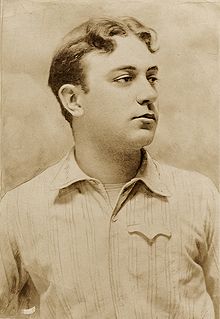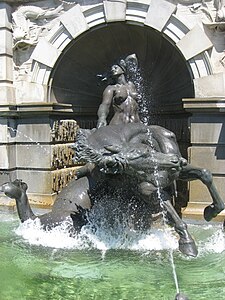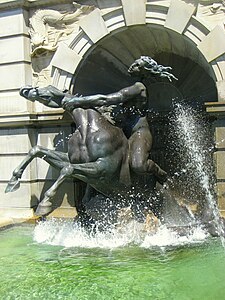Court of Neptune Fountain
Court of Neptune Fountain | |
 Court of Neptune Fountain in 2013 | |
| Location | Thomas Jefferson Building, Washington, D.C. |
|---|---|
| Coordinates | 38°53′19″N 77°00′21″W / 38.888681°N 77.005770°W |
| Built | 1898 |
| Architect | Roland Hinton Perry, Albert Weinert (sculptors) John L. Smithmeyer, Paul J. Pelz, Edward Pearce Casey (architects) Henry-Bonnard Bronze Company (founder) |
| NRHP reference No. | 66000000 |
| Significant dates | |
| Added to NRHP | December 21, 1965 |
| Designated DCIHS | November 8, 1964 |
The Court of Neptune Fountain is a fountain adorned with bronze sculptures made by Roland Hinton Perry and Albert Weinert in the late 1890s. Jerome Connor may have assisted in their manufacture. The architects for the project, which was completed in 1898, included John L. Smithmeyer, Paul J. Pelz, and Edward Pearce Casey, while the founding was completed by the Henry-Bonnard Bronze Company. The fountain is located on the west side of the Thomas Jefferson Building, the main building for the Library of Congress in Washington, D.C. The project took three years to complete.
The granite semi-circular fountain includes multiple bronze sculptures, including Neptune, his Tritons, and naiads. Neptune and both naiads are in granite niches that serve as the retaining wall for Neptune Plaza, which is between the fountain and main entrance to the building. Other bronze sculptures in the fountain are frogs, turtles, and a sea serpent. Each of these spout water, as do the Tritons with conch shells. Art critic Charles Henry Caffin described it as being the most ornate fountain in the U.S. at that time.
The fountain has been cleaned and restored on many occasions, sometimes to repair the sculptures, and other times to clean the basin and niches. As part of the Thomas Jefferson Building, it is a contributing property to the building's designation as a National Historic Landmark. The building is also listed on the District of Columbia Inventory of Historic Sites.
History
[edit]Construction
[edit]Construction of the Thomas Jefferson Building, the French Renaissance main building of the Library of Congress (LOC), lasted from 1886 to 1897. Before then the LOC had been housed in the United States Capitol. The building features many ornate details, including a large water fountain on the west side, below the main entrance. Two stairwells and eight pairs of ionic columns are also features on the west side of the building.[1]
During construction of what was then-called the Library of Congress Building, plans were made to install an ornate fountain at street-level. The sculptor chosen to design the fountain and its statues was Roland Hinton Perry, whose other works include Commonwealth in Pennsylvania, the Thompson Elk Fountain in Oregon, and the Perry Lions on the Taft Bridge in Washington, D.C. After studying at the Beaux-Arts de Paris, Académie Julian, and the Académie Delécluse, Perry was commissioned in 1894 to create some of the building's interior bas-reliefs. His work was well received and two years later, he was commissioned to design the fountain.[1][2][3]
By late 1896, most of the interior and exterior features of the building had been completed. Construction crews began preparing the area for the fountain around the same time. Also by late 1896, the Neptune sculpture had been designed by Perry and was waiting for the Henry-Bonnard Bronze Co. to complete the founding.[4] The foundry shipped each piece of the sculpture to the fountain site after its completion.[5]

In addition to Perry, architect Albert Weinert designed some of the smaller sculptural pieces, such as the dolphins.[5] It is possible Jerome Connor, whose other works in Washington, D.C., include Nuns of the Battlefield and the statue of John Carroll, helped create some of the sculptures.[6] The architects who worked on the fountain are Edward Pearce Casey, John L. Smithmeyer, and Paul J. Pelz, who was the main architect of the Library of Congress Building.[7]
In January 1898, some of the last of the fountain's sculptures arrived at the construction site.[8] By the next month, the last piece of the fountain, a naiad, was installed.[9] Following its completion on February 23, 1898, Perry stated: "I have tried to embody by Neptune and the Naiads the physical joy felt in masses of rushing water. Of course one loses a great deal of this effect when the fountain does not play. The powerful muscularity and strong movement of the groups seemed to me, when I modeled those figures, to represent the intense activity, the restlessness, and push of our peoples."[3][5] Art critic Charles Henry Caffin said the fountain was the most ornate one in the U.S.[10]
Later history
[edit]The Library of Congress Building, including the fountain, was added to the District of Columbia Inventory of Historic Sites on November 8, 1964. The next year, the building was designated a National Historic Landmark on December 21, 1965.[11] The fountain and its sculptures have been cleaned and restored on numerous occasions.[12] During the mid-1980s, the fountain was repaired and covered in scaffolding for almost two years. The repairs included broken concrete and issues with the water pipes.[13]
A major cleaning took place in 2017 when mineral buildup and stains were removed, masonry was repaired, and the fountain's basin was repainted.[5] The fountain has also been vandalized. In 1998, someone removed the fig leaf covering Neptune's genitals. It was not replaced because there were no known photographs that showed details of the leaf, therefore making it difficult to replicate one, and also because visitors did not seem to care about the missing piece.[12]
In 2001, the fountain was used as an example of nude statuary in Washington, D.C., along with many other artworks. The reasoning behind its inclusion was after U.S. Senator Mitch McConnell denied permission to display nude artworks in the Russell Senate Office Building rotunda. Artist Raymond Wiger responded by pointing out the Court of Neptune Fountain features nudity and said "It's probably the most explicit...just a block across from the U.S. Capitol."[14]
Location and design
[edit]Location
[edit]The Court of Neptune Fountain is located in front of the Thomas Jefferson Building's west façade. The fountain faces First Street SE, between East Capitol Street and Independence Avenue SE. Between the fountain and the building's main entrance is the Neptune Plaza.[15] The fountain is at street-level, giving easy access to visitors walking past the site. According to a curator from the Office of the Architect of the Capitol, "[the fountain] is kind of a focal point of the exterior of the building. It greets people when they come into the library."[12] A reporter for Roll Call said the "Court of Neptune Fountain serves several purposes: aesthetic beauty, historical reminder and doorman to the Library."[12]
Design
[edit]Perry's design for the fountain was inspired by the Trevi Fountain in Rome.[5] In addition to the bronze sculptures of Neptune and naiads, there is a bronze Triton flanking each side of Neptune, with water spouting from the conch shells they hold. Additional jets of water spout from a bronze sea serpent in front of Neptune, four bronze frogs, and two bronze turtles. The bronze sculptures on either side of Neptune are riding seahorses.[7][16] Each of the three main sculptures are in granite niches that are topped by bas-reliefs of stalactites and dolphins.[7]
The fountain's semi-circular basin is 50-feet (15 m) long and is set in the plaza's retaining wall. The two naiads measure approximately 10-feet (3 m) tall while Neptune, who is seated on large rocks, measures 12-feet (3.7 m) tall.[7] He is depicted as an older man with long hair and a beard, but one with great physical strength.[10] The Tritons are also 12-feet tall and are beckoning sea people with their conch shells. The sea serpent in front of Neptune awaits orders from their king.[17]
-
A class looking at the fountain in 1899
-
Neptune sculpture
-
Triton on the south side of the fountain
-
Triton on the north side of the fountain
-
Fountain at night
See also
[edit]- History of fountains in the United States
- List of public art in Washington, D.C., Ward 6
- Outdoor sculpture in Washington, D.C.
References
[edit]- ^ a b Schwartz, Nancy B. (1964). National Register of Historic Places Nomination Form - Library of Congress. National Park Service.
- ^ "R.H. Perry is Dead, Sculptor and Painter". The New York Times. October 29, 1941. p. 23. ProQuest 105696330. Retrieved January 31, 2024.
- ^ a b Reed, Henry Hope; Cole, John Y (1997). Library Of Congress: Its Construction Architecture And Decoration. WW Norton. p. 243. ISBN 978-0-393-04563-5.
- ^ "Library Fountain". The Evening Star. November 7, 1896. p. 16. Retrieved January 31, 2024.
- ^ a b c d e "Court of Neptune". Architect of the Capitol. Archived from the original on October 3, 2023. Retrieved January 31, 2024.
- ^ "Jerome Connor". PBS. Archived from the original on December 4, 2009. Retrieved January 31, 2024.
{{cite web}}: CS1 maint: bot: original URL status unknown (link) - ^ a b c d "The Court of Neptune Fountain, (sculpture)". Smithsonian Institution Archives of American Art. Archived from the original on March 18, 2022. Retrieved January 31, 2024.
- ^ "The Naiad in Position". The Evening Star. January 29, 1898. p. 1. Retrieved January 31, 2024.
- ^ "Art & Artists". The Evening Star. February 5, 1898. p. 16. Archived from the original on January 31, 2024. Retrieved January 31, 2024.
- ^ a b Charles Henry, Caffin (1897). Handbook of the New Library of Congress. Curtis & Cameron. pp. 11–13. Archived from the original on 2024-01-31. Retrieved 2024-01-31.
- ^ "District of Columbia Inventory of Historic Sites" (PDF). District of Columbia Office of Planning - Historic Preservation Office. Archived (PDF) from the original on July 31, 2017. Retrieved January 31, 2024.
- ^ a b c d Macel, Emily (December 16, 2002). "Larger Than Life: Neptune Towers Over Library of Congress' Jefferson Building". Roll Call. ProQuest 326742849. Archived from the original on January 31, 2024. Retrieved January 31, 2024.
- ^ Molotsky, Wayne King and Irvin (April 6, 1986). "Briefings". The New York Times. pp. A52. ProQuest 425912235. Archived from the original on January 31, 2024. Retrieved January 31, 2024.
- ^ Miller, Nicole M. (October 24, 2002). "Is Nude Rude? The Great Federal Coverup". The Washington Post. pp. C05. Archived from the original on January 31, 2024. Retrieved January 31, 2024.
- ^ "The Neptune Plaza". Library of Congress Magazine. 3 (4). 2014. Archived from the original on 2024-01-31. Retrieved 2024-01-31.
- ^ Applewhite, E.J. (1993). Washington Itself: An Informal Guide to the Capital of the United States. Madison Books. pp. 262–263. ISBN 9781461733386. Archived from the original on 2024-01-31. Retrieved 2024-01-31.
- ^ Goode, James M. (1974). The Outdoor Sculpture of Washington, D.C. Smithsonian Institution Press. pp. 69–70.
External links
[edit] Media related to Court of Neptune Fountain at Wikimedia Commons
Media related to Court of Neptune Fountain at Wikimedia Commons
- Historic district contributing properties
- 1898 establishments in the United States
- 1898 sculptures
- Animal sculptures in Washington, D.C.
- Bronze sculptures in Washington, D.C.
- Capitol Hill
- Fountains in Washington, D.C.
- Monuments and memorials in Washington, D.C.
- Nude sculptures in Washington, D.C.
- Outdoor sculptures in Washington, D.C.
- Sculptures by Roland Hinton Perry
- Sculptures of dolphins
- Sculptures of horses
- Sculptures of Neptune
- Sculptures of seashells
- Statues in Washington, D.C.





